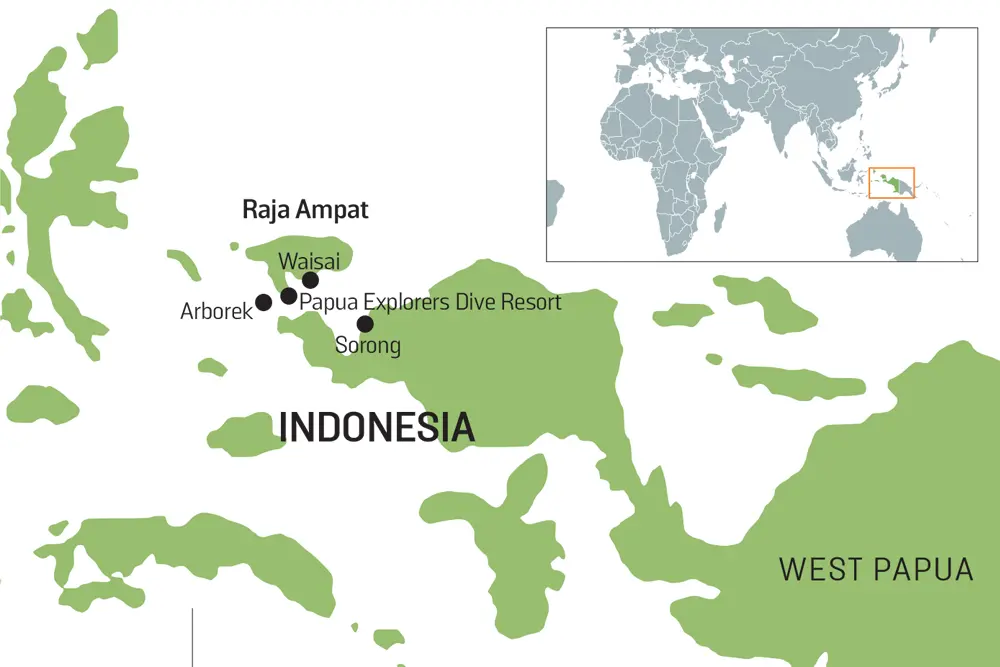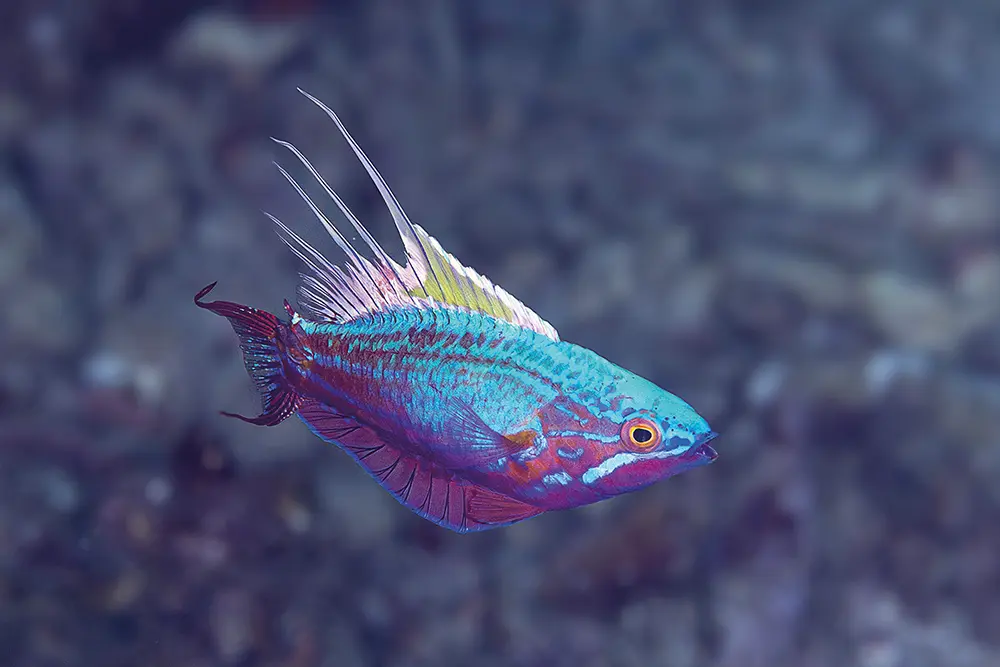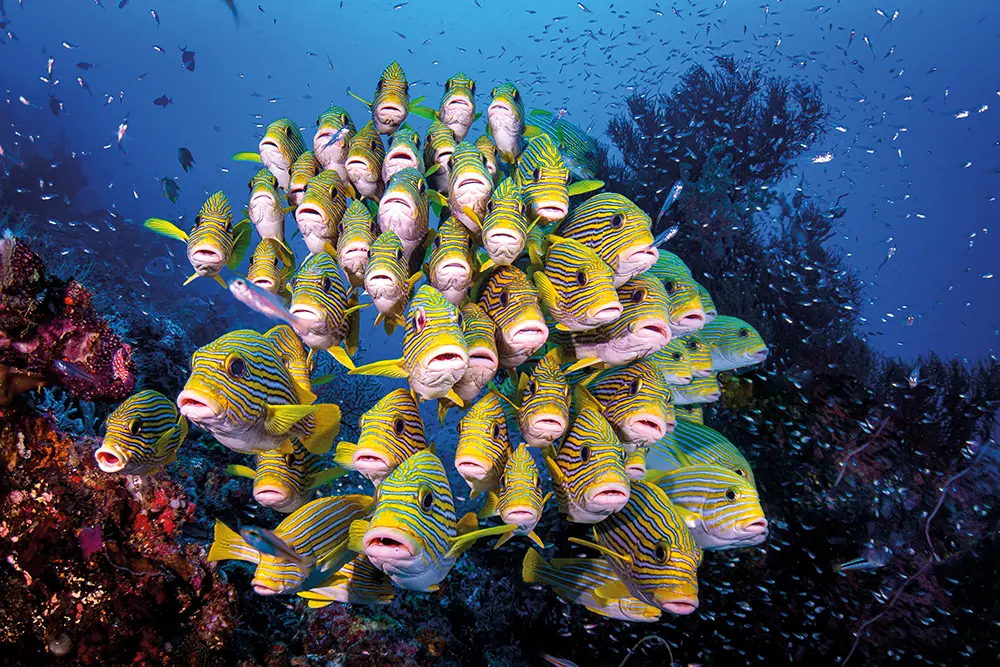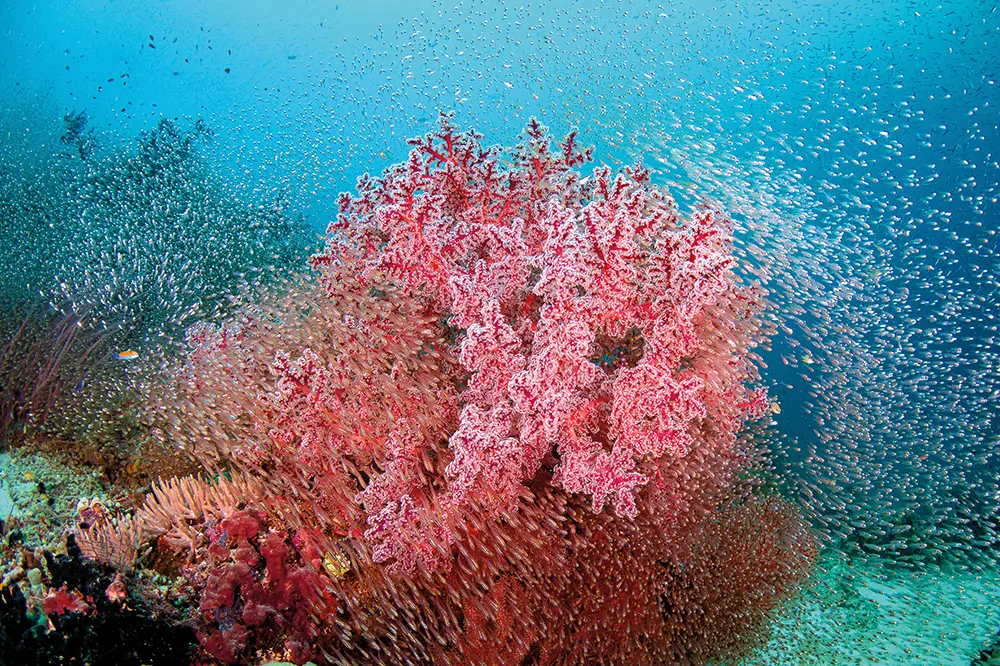
Writer and photographer Todd Aki compares back-to-back week-long dive trips to Raja Ampat, staying in a humble homestay, then at a luxury resort
Words and photographs by Todd Aki
Raja Ampat is unquestionably one of the best dive destinations in the world. It is also a very expensive place to dive, either by liveaboard or from a resort. But there is a third option: a homestay.
This little-known alternative can cost as little as a quarter of the price of the standard Raja accommodation options. It’s therefore a mighty tempting proposition. But does paying a budget price risk getting a budget experience?
To find out, I booked back-to-back stays in Raja, first in a resort and then at a homestay. Here’s what I discovered.

THE ROAD LESS TRAVELLED
The first glaring difference is getting to the accommodation. At Papua Explorers, the resort where I stayed, a resort representative met me at the airport and whisked me off to a hotel where I had a tasty breakfast buffet while waiting for other guests.
At noon, I was driven to the pier, where a nice resort boat took me directly to the resort, a little over an hour away. The whole transfer was effortless and relaxing.
This was not the case with the homestay. Upon exiting the airport, you need to find a taxi to take you to the public ferry. Next, you wait in line for a ferry ticket, then for some unexplained reason, wait in another line to redeem your ticket to get another ticket.

You then lug your luggage 50 metres to the ferry. If you are lucky, you will find a seat on the lower deck. If not, you’ll need to carry your luggage upstairs with you. I cheated and spent $3 (£2.30) for a porter as I was carrying nearly 50kg (110lbs) of dive and photo gear. It was the best three dollars I have ever spent.
After a two-hour ferry ride, you arrive on the island of Waisai and walk another 50m to get a permit to enter Raja. Your homestay boat will hopefully be waiting for you. It’s usually open top, narrow and loud. If there are any waves, it will be a bumpy ride. And bring a poncho, because if it rains or the ocean is rough, you will get soaked by ocean spray.
Depending on the location of your homestay, the boat ride could take 60-90 minutes.
CREATURE COMFORTS

Most resorts in Raja are well furnished and Papua Explorers was no exception. My spacious room had a hot water shower, a western flush toilet, a table and chair, and a covered veranda with a sofa. Air conditioning kept everything comfortable.
Right off the veranda were steps into the ocean, where on higher tides you could swim out to the dive centre or snorkel on the house reef.
The resort’s dining area was spacious, offering amazing food with plentiful choices for each meal, as well as delicious desserts.
My homestay, on the island of Arborek, was a very different affair. The room was tiny and very basic, with only a mattress on the floor and a small table with a fan, rather than air conditioning.

I paid a bit more than average for my homestay, so it was new and very clean, but the cracks between the wooden floorboards led straight to the ocean, so caution was required if I didn’t want my things to end up in the sea.
There was a plus side of this proximity to the water: from my bungalow, I could see baby sharks putting on a show at night, as well as a large school of bigeye scad and batfish.
Electricity is often only available at night. Once during my stay, the power went off for over a day, but luckily, my homestay had a generator. It was a mystery what hours they ran it, but fortunately, I was never caught without power.
In my homestay, there was no hot water. In fact, many Indonesian homestays have no running water at all. There is typically a communal shower or bathroom, in which you wash by dipping a ladle in a tub of water and pouring it over yourself.

Given the lack of air conditioning, the cold water was actually quite welcome. Toilets in many homestays are just as rudimentary: you flush by pouring water from a ladle into the pan.
As the owners of homestays often speak very limited English, there is no orientation, so you pick up what you need to know – meal times and the like – from fellow guests.
Food tends to be very basic: pastries for breakfast; for lunch and dinner it was either chicken or fish with rice and vegetables.
RESORT OR HOMESTAY: THE DIVING

Now for the most important thing: the diving. Upon arrival at Papua Explorers, the dive manager (just one of a plethora of managers looking after all aspects of the place) gave us a long briefing. They asked for dive certificates, we filled in several liability forms, and we were given an explanation of the logistics of diving at the resort.
We could do up to three dives each day, plus a twilight or night dive. We were told how to enter the water from the dive boat and how to get back on. If separated, we were to do a one-minute search and, if still separated, everyone would stop the dive and meet at the surface.
We were also told not to use strobes when shooting pygmy seahorses and manta rays – presumably in order not to cause them undue stress.

As you’d imagine with such good processes in place, the dive day ran like clockwork. I was fortunate to dive with the best guide I’ve ever had: she was always aware of her divers, was a great spotter and had such an infectious, happy personality you could not help but smile when you were around her.
My dive company on Arborek had a less rigorous approach. They did not offer an orientation, ask for certification cards, or give me any forms to fill out.
They did two morning dives a day and sometimes an afternoon dive, and offered a night dive only once during my six-day trip.
We were told to meet at 7:30 am, but the dive boat almost never left until 8:30 am. When it was time to leave, the boat’s engine caused problems every single day.

On one occasion, they did an engine swap from another boat, but as we headed out, that engine stopped working too so we went back to shore to get it fixed.
To be fair to the company, even with all these issues, all the scheduled dives took place.
One day I lost the group while shooting a particularly beautiful subject – I just continued my dive solo, surfacing at the agreed-upon time with no one seemingly concerned.
Maybe they recognised that I was a competent diver and decided it was safe to let me do my own thing.

Ultimately, my experience of diving at the resort and homestay were pretty similar. I dived all the famous dive sites and had a great time.
Both places have fantastic house reefs, with different strengths depending on your preferences. Papua Explorers has great macro critters – my fabulous guide found me a blue-ringed octopus on almost every night dive.
But Arborek was my personal favourite, boasting glorious hard and soft coral gardens, schools of fish, big and small, as well as rarer treasures such as flasher wrasses and even a regal tang.
A MATTER OF TASTE

Arborek is a very small island, meaning you can’t help but bump into kids playing with homemade toys or adults doing daily chores. After a day or two, I felt like a part of the community, and really valued this element of my trip.
A special mention needs to be made of Githa, the owner of the dive shop on Arborek, along with her husband. She is a driving force in protecting Arborek’s reefs, involved in conservation efforts such as restoring the hard coral, as well as helping improve the lives of local residents, especially women.
Papua Explorers, on the other hand, is similar to other resorts, where guests are expected to stay on resort property. You can hike to a nearby village, but you’ll need to make special arrangements to do so.

The booking process was easy for both trips. With Papua Explorers, you make a deposit by wiring money, and then pay the balance before arrival – $3,152 all-inclusive for seven days’ diving in my case.
You’ll also fill out some forms and send over pictures of your passport and dive certifications ahead of your trip.
Organising the homestay was actually even easier – stayrajaampat.com is an amazingly comprehensive website.
It lists homestays by location and includes thorough descriptions and helpful, accurate reviews. It has a great FAQ section explaining everything you need to know.

Most importantly, the website handles payments. You pay the entire amount upfront – $1,070 for my week’s stay and
diving on Arborek – and can use a credit card.
Typically, your only correspondence with the owners of the homestay is an exchange of WhatsApp messages when you have boarded the ferry so they can meet you at Waisai.
What is the final verdict– homestay or resort? As with most things in life, you get what you pay for. If you want to be pampered and have a smoothly oiled scuba diving experience, go with a resort.
If you want to save money, are happy to be flexible, value getting to know the local people, and don’t mind roughing it a bit, a homestay might just be your ideal next dive trip.
Todd stayed at Papua Explorers Resort and Raja Ampat Sunset Homestay
There’s no escape, the robots are taking over!
More great reads from our magazine
- Artificial Intelligence in underwater photography – a force for good, or evil?
- Liveaboard safety – how divers can change it and when to walk away
- DIVE’s Big Shot Portraits – THE WINNERS!
- How to become a better diver: never stop learning
- The National Lobster Hatchery – giving lobsters a helping hand



